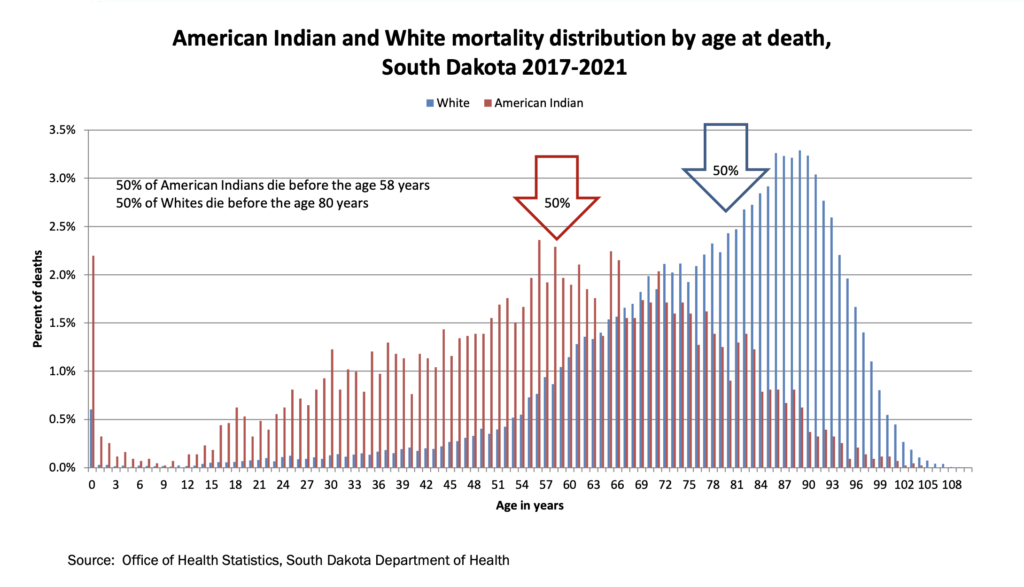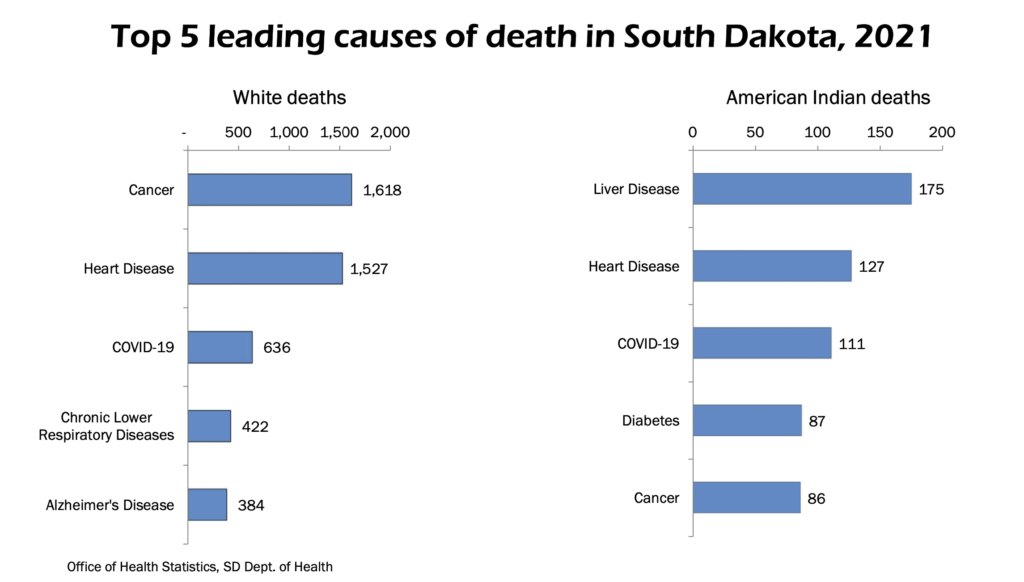Here’s one chilling representation of health disparities between American Indians and white folks in South Dakota. According to the Department of Health’s presentation to the Government Operations and Audit Committee last week, based on the ages people died at from 2017 through 2021, half of South Dakota’s Indians die before reaching age 58, while half of South Dakota’s whites make it to age 80:

Notice the awful disparity in child deaths between Indians and whites. 2.2% of deaths among Indians are babies who don’t make it to their first birthday. Only 0.6% of deaths among whites are infants.
The leading causes of death differ between South Dakota’s Indians and whites. Cancer is the top killer of whites but only #5 among Indians. The leading killer among Indians is liver disease.

Heart disease and covid ranked #2 and #3 in killing whites and Indians, but notice that covid seems to been proportionally more deadly among the Indian population. White folks appear more prone to respiratory disease, and since more of them live longer, more of them die from Alzheimer’s. Indians are more likely to die of diabetes, their #4 cause of death.
A state can take several actions to help a population disproportionately affected by liver disease and diabetes:
1. Improve healthcare access: Ensure that healthcare services, including primary care, screening, and treatment facilities, are easily accessible to everyone in the affected population. Increase the number of healthcare professionals and resources in areas where they are lacking.
2. Increase health education and awareness: Launch public health campaigns and educational initiatives to raise awareness about liver disease and diabetes risk factors, prevention measures, and early intervention. Educate the population about healthy lifestyle choices, including nutrition and physical activity.
3. Implement preventive measures: Develop and implement preventive strategies aimed at reducing the incidence of liver disease and diabetes. This could include promoting vaccination against hepatitis infections, reducing alcohol and substance abuse, and encouraging regular health screenings for early detection.
4. Enhance community outreach: Establish community health programs that target the population at risk. Engage community leaders, local organizations, and healthcare providers to collaborate and address the specific needs of the affected population. Offer support groups and counseling services to assist individuals in managing their condition and making positive life changes.
5. Improve data collection and research: Invest in data collection and research to better understand the causes, risk factors, and impacts of liver disease and diabetes within the population. This can help develop more effective prevention strategies, treatment options, and healthcare policies.
6. Increase funding and resources: Allocate sufficient funding and resources to support healthcare initiatives, research, and community programs focused on liver disease and diabetes. This can include funding for medical research, treatment facilities, community clinics, and education campaigns.
7. Collaborate with healthcare professionals and organizations: Foster partnerships with healthcare providers, medical associations, and non-profit organizations specializing in liver disease and diabetes. Leverage their expertise, knowledge, and resources to develop comprehensive programs and policies.
8. Policy reforms: Advocate for policy changes that support population health and address the underlying social determinants that contribute to liver disease and diabetes. This could include regulations on the marketing and availability of unhealthy food and beverages, promoting physical activity through urban planning, or implementing workplace wellness programs.
9. Address socioeconomic disparities: Identify and address socioeconomic factors that contribute to the disproportionate impact of liver disease and diabetes. This may involve initiatives to reduce poverty, improve access to healthy food options, and provide educational programs focused on health management and healthy lifestyles.
10. Monitor progress and evaluation: Continuously monitor the impact of interventions and programs through data collection and evaluation. Regularly assess the effectiveness of strategies implemented and make necessary adjustments to ensure the best outcomes for the population.
– AI Generated
Shameful. Health should be youth’s greatest asset. We don’t give the children that number one weapon to start them off. We give them silent burials. They have collective memories, ya know. We will be sorry for that one.
It makes me cry to see this. It makes me seethe to hear our governor celebrate the hundreds of millions of surplus taxes put in her rainy day fund thanks to her ‘fiscal responsibility’. Shame.
It isn’t goddamn nds. It is negligent homicide with an added hate crime. We need to fix this out of spite and anger. If you are not spitting mad seeing this, you too are rotten.
Shameful and ignored by 40% of white people who believe they’re the REAL victims in our collective.
The former President fuels this “victim mentality” with his ulterior motive of promoting white supremacy.
There is a growing movement among Democrats and others to fund Medicare for all but I like the idea of rolling the funding for Obamacare, TriCare, Medicare, the Indian Health Service and the VHA together then offering Medicaid for all by increasing the estate tax and raising income taxes for the 1%.
American Indians in South Dakota have been dying young for decades and decades. I have no solutions or answers, just observations. It seems like it was worse in the 70’s as I recall the average American Indian in SD did not see 50 years..
Though cause of death is not that often stated in the obits I see from the Chamberlain, SD or Valentine, NE funeral homes, suicide is a big cause, but not exclusive to the American Indian community.
Cory, these graphs say it all. Thank You
I’m sorry to say this, but alot of the SD natives drink and some of them don’t value life.
Black & White Cookies for you …
RACIAL IMBALANCE NEWS:
– White male business owners are suing Massachusets for discrimination in pandemic relief program.
The plaintiffs, represented by a conservative national law firm, say that a state program to help women and people of color recover from the pandemic violates their constitutional rights.- BostonGlobe
– Black musician sues white nationalist Patriot Front over alleged attack in Boston.
The lawsuit seeks to expose the white nationalist organization to the kind of financial penalties imposed on organizers of the 2017 “Unite the Right” rally in Charlottesville, Va., through civil litigation. – BostonGlobe